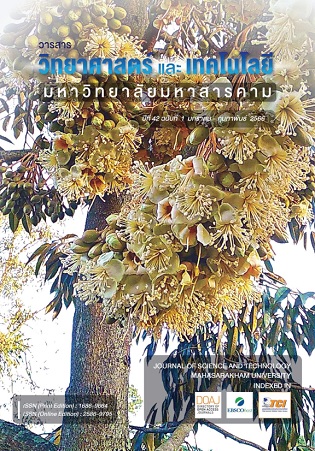Determination of Some Heavy Metals in Edible Bivalve Marketed , Chanthaburi Provice
Main Article Content
Abstract
The study of determinations of copper, zinc, lead and cadmium in blood cockles, mussels and oysters from Chanthaburi provice were analyzed in dry and wet seasons. These samples were collected from the Namphu market, Charoen Suk market, Khao Rai Ya Local Market, Laem Sing pier, and Khlung pier during dry and wet seasons 2020. The samples were digested by the wet degradation method. The result showed that the concentrations of copper lead and cadmium in edible bivalves mollusks were 2.087-28.413, 0.003-0.034, and 0.032-0.846 mg kg-1 (Wet weight) respectively are lower than the standard limitation in sea food of the Ministry of Public Health. While, the concentrations of zinc in oysters in wet season are higher than the standard limitation. Limit of detection of copper, zinc, lead and cadmium were 0.076, 0.094, 0.002, and 0.013 mg L-1, respectively and the recoveries ranged from 81-98, respectively. However, the safety assessments of heavy metals from edible bivalves mollusks samples consuming are still safe level.
Article Details
References
กระทรวงสาธารณสุข. (2529). พระราชบัญญัติโลหะหนักในอาหาร. กระทรวงสาธารณสุข.
ณัฐวร ขันธิกุล, เชษฐพงษ์ เมฆสัมพันธ์ และณิศรา ถาวรโสตร์. (2020). การเปลี่ยนแปลงของปริมาณโลหะหนักในดินตะกอนตามฤดูกาลและพื้นที่บริเวณพื้นที่อ่าวไทยตอนใน. Thai Science and Technology Journal. https://doi: 10.14456/tstj.2020.138.
ทิพย์วรรณ แซ่มา. (2553). การปนเปื้อนโลหะหนักในหอยสองฝาที่มีความสำคัญทางเศรษฐกิจ บริเวณดอนหอยหลอดจังหวัดสมุทรสงคราม. การประชุมทางวิชาการของมหาวิทยาลัยเกษตรศาสตร์ ครั้งที่ 48 (หน้า 191-198).
พิพัฒน์ นพคุณ. (2541). แคดเมียมในอาหารทะเล. วารสารกรมวิทยาศาสตร์การแพทย์, 40 (3), 341-345.
แววตา ทองระอา ฉลวย มุสิกะ วันชัย วงสุดาวรรณ และ อาวุธหมั่นหาผล. (2557). การประเมินความเสี่ยงต่อสุขภาพในการได้รับโลหะหนักจากการบริโภคอาหารทะเลบริเวณชายฝั่งนิคมอุตสาหกรรมมาบตาพุด จังหวัดระยอง. วารสารวิทยาศาสตร์บูรพา, 19 (2), 39-54.
ศุภลักษณ์ พวงสุวรรณ. (2557). ปริมาณโลหะหนักบางชนิดในปลาทูน่าบริเวณแนวสันเขาใต้น้ำ 90 E̊ . [วิทยานิพนธ์วิทยาศาสตรมหาบัณฑิต,มหาวิทยาลัยสงขลานครินทร์].
สุภาน้อย ทรัพย์สินเสริม ประทุมวัลย์ เจริญพร ภัสราภา แก้วเนิน และนิศานาถ ตัณฑัยย์. (2563). ปริมาณโลหะหนักสารชีวพิษ และเชื้อ Escherichia coli ในหอยสองฝาของประเทศไทย. กองตรวจสอบคุณภาพสินค้าประมงกรมประมง กระทรวงเกษตรและสหกรณ์.
สุวัจน์ ธัญรส. (2549). โลหะหนัก, มลพิษทางทะเลและชายฝั่ง. โอ.เอส.พริ้นติ้ง เฮ้าส์.
Abdullah, M.H., Sidi, J., & Aris, A.Z. (2007). Heavy metals (Cd, Cu, Cr, Pb and Zn) in Meretrix Roding, water and sediments from estuaries in Sabah, North Borneo. Inter Journal of Environmental and Science Education, 2 (3), 69-74.
AOAC. (2005). Official method of analysis (15th ed.), Arlington: The Association of Official Analytical Chemists.
Cajaraville, M.P., Bebianno, M.J., Blasco, J., Porte, C., Sarasquete, C., & Viarenge, A. (2000). The use of biomarkers to assess the impact of pollution in coastal environments of the ierian peninsula: a practical approach. Science of the Total Environment Journal, 247, 295-311.
FAO. (1983). Compilation of legal limits for hazardous substances in fish and fishery products. FAO Fishery Circular No.464. Food and Agricultrue Organizaton.
Funes, V., Alhama, J., Navas, J.I., Lopez-Barea, J., & Peinado, J. (2006). Ecotoxicological effects of metal pollution in two mollusk species from the Spanish south atlantic littoral. Journal of Environmental Pollution, 139, 214-223.
Heidari, B., Bakhtiari, A.R., & Shirneshan, G. (2013). Concentrations of Cd, Cu, Pb and Zn in soft tissue of oyster (Saccostrea cucullata) collected form the Lengeh Port coast, Persian Gulf, Iran: A comparison with the permissible limits for public health. Food
Chemistry, 141, 3014-19.
Musika, C., Wongsudawan, W. and Thongra- ar, W. (2014). Distribution and accumulation of heavy metals in sediments of the Inner Gulf of Thailand, Proceedings of the 4th Marine Science: Blue Ocean Science, 569-580. Prince of Songkla University, Songkla,
PCD. (2015). The report of the water pollution situation and management year 1998-1999. Ministry of Natural Resources and Envoronment. Thailand.
Potipat, J., Tangkrock-olan, N., Helander, H.F. (2015). Bioconcentration factor (BCF) and depuration of heavy metals of oysters (Saccostrea cucullata) and mussles (Perna viridis) in the river basins of coastal area of Chantaburi provice, Gulf of Thailand.
EnvironmentAsia, 8 (2), 118-128.
Raine, R.M. (1994). Current land use and changes in land use over time in the coastal zone of Chanthaburi Province, Thailand. Biological Conservation, 67 (3), 201-04.
Velusamy, A., Kumar, P.S., Ram, A., & Chinnadurai, S. (2014). Bioaccumulation of heavy metals in commercially important marine fishes from Mumbai harbor, India. Journal of Marine Pollution Bulletin, 81, 218-224.
WHO. (1984) List of maximum levels recommended for contaminants by the joint FAO/WHO codex alimentarius commission. Second Series. WHO.
WHO. (1982). Toxicological evaluation of certain food additives. World Health Organization.


